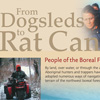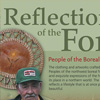- Home
- Background
- Land Use Studies: 1960s-Present
- Land Use Studies in Canada
- Land Use Studies Internationally
- Study, Methodology & Practice
- Perspectives
- Appropriate Land Use - Aboriginal Perspective
- Resource Management
- Sustainability
- Cultural Uses
- Educational Uses
- Litigation
- Traditional Knowledge
- TUS in Alberta
- The Alberta Studies
- Multimedia
Perspectives
Appropriate Land Use, Aboriginal Perspectives
The relationship with lands and resources is a complex one for members of the Aboriginal community, caught as they are in the flux between traditional knowledge and modernity. Their most ancient presence in Alberta, through the generations, has gained them a great familiarity with the resources of their environment, but the last 300 years have been for them a period of constant change and adaptation. Although the Government of Canada has signed Treaties with First Nations' leaders, it is only due to very recent Supreme Court decisions (Haida Nation v. British Columbia 2004 and Mikisew Cree First Nation v. Canada 2005) that, if developmental activities are to take place on lands reserved for First Nations, corporations and other entities that are seeking to undertake development must give fair and honest consideration to those who live there.
 In Alberta, the problem can be lesser for the First Nations whose reserves were designated under Treaty 6 or 7, as the boundaries of these reserves were specified at the time of signing. For the Treaty 8 First Nations, this is a more complicated matter as their right to resources is not always limited to a particular territory. Nevertheless, throughout Alberta (and elsewhere in Canada), the interests of all First Nations are supposed to be dealt with fairly by governments or developers.
In Alberta, the problem can be lesser for the First Nations whose reserves were designated under Treaty 6 or 7, as the boundaries of these reserves were specified at the time of signing. For the Treaty 8 First Nations, this is a more complicated matter as their right to resources is not always limited to a particular territory. Nevertheless, throughout Alberta (and elsewhere in Canada), the interests of all First Nations are supposed to be dealt with fairly by governments or developers.
Although the concept of land use is clearly defined in Western culture, that of ownership of land is still a relatively new one to members of First Nations. Theirs has been more a view of stewardship of the land, something which they take very seriously. Not only does this apply to the resources of the territory under question, which are a source of food for those who reside there, there is also a sense of the sacred with respect to land. When Traditional Land Use Studies (TUS) are undertake, they must also include the Aboriginal perspectives towards certain places considered for their spiritual value. This includes not only burial sites, but other places valued for a particular, intangible presence that is considered sacred or holy.
For example, traditional land use can be observed in the ancient belief of the holiness of Lac Sainte Anne in Northern Alberta, where a large gathering of pilgrims, mostly of Aboriginal origin, have met for more than 100 years during the last week of July. The original name of the lake is Manitosakahigan, or lake of the Manitou, or Spirit Lake, but it was also commonly known by the fur traders as Devil's Lake. The name was changed around 1850 by the first Catholic missionary to establish a mission at the lakeside community where a group of Métis hunters were living. Creating a pilgrimage site some 40 years later, reinforced the ancient bond, marrying the ancient belief with that of Christianity.
To better understand traditional land use by Aboriginal Peoples, one must also consider their places of residence, be they seasonal sites used for hunting, fishing or gathering, or long-standing home sites. TUS include many maps detailing different aspects of land use. Traditional place names are part of the information gathered. Names that the Aboriginal Peoples gave to the places they occupied throughout their territory, as well as the evolution of these names since the early fur trade period to the present day, can speak about the history of an area under study. Books do not necessarily hold all the answers.
Local residents and Native speakers can reveal much about the way of life of long ago. Take, for example, the name of Smoky Lake, a northern Alberta community located just north of a large bend on the North Saskatchewan River. Officially, it is said in fur trade journals from the late 18th century that this lake was so named because of a mist on the lake.(1) However, Native speakers will tell you differently. Elders from the region say that wild turnip, which was an important food source for the Aboriginal Peoples who ranged through this area, is found in abundant supply. The problem was that these nomadic tribes were also traditional enemies but, as this food supply was so important, a pact was kept during this short season that consisted of the smoking of the pipe of peace by the lake so that, during the whole time the harvesting lasted, the traditional enemies respected each other and lived peacefully side by side. Over 200 years ago, the original name was improperly translated from the Cree, as it really means, "Smoking Lake," that is, "lake where the pipe is smoked" and not "the lake which smokes."
A similar error in translation can also be found at nearby Saddle Lake, which according to the official place names books of Alberta refers to a cold and hungry winter where so many Aboriginal fishermen huddled by holes in the ice to fish, it made the lake look as if it was covered with saddles, a rather puzzling image(2). When asked whether the meaning was correct, a Cree speaker from Wabasca easily explained that a mistake had long ago been made in the transcription and translation of the Cree name that, in reality, refers to a feared shaman who had once lived there, and that saddles had nothing to do with the place.
 As we can see from the above examples, in spite of the great lengths that are taken by academics to prepare accurate books, such as indexes of place names, the importance of getting the story from those who speak the language and are familiar with the culture are essential to understanding how the land was used. With this in mind, we can stop looking for a lake that smokes, or a lake that was used for ice fishing or where people saddled up. In the first case, we learn about naturally-occurring plants in the area and their use in the annual migration of the Aboriginal Peoples in the pre contact period; in the second case, it could avoid a wild goose chase concerning ice fishing and fish resources of the lake, again pre-contact.
As we can see from the above examples, in spite of the great lengths that are taken by academics to prepare accurate books, such as indexes of place names, the importance of getting the story from those who speak the language and are familiar with the culture are essential to understanding how the land was used. With this in mind, we can stop looking for a lake that smokes, or a lake that was used for ice fishing or where people saddled up. In the first case, we learn about naturally-occurring plants in the area and their use in the annual migration of the Aboriginal Peoples in the pre contact period; in the second case, it could avoid a wild goose chase concerning ice fishing and fish resources of the lake, again pre-contact.
Studies must also consider the sense of ownership/stewardship that Aboriginals have with their land and the territories they use. Traplines, for example, evolved to a system of permits obtained from the provincial government usually on Crown Land. If these large areas did not technically belong to the Aboriginals who exploited them, through long-term use of the lands, often transferred from one generation to the next, there came to be a considerable knowledge about the vegetation and the wildlife in those spaces. In addition, there was also a sense that these places belonged to them, akin to ownership, for having crossed the terrain again and again, for having lived upon it for so long. Familiar spots and campsites were given names. Particularities of the land were noted: a salt lick, an outcropping with a good view for hunting, a marsh where ducks nested and eggs could be easily harvested, creeks where the fish rose to spawn in the spring. By gathering this sort of information, which can only be obtained from those who know and live on the land and have had this knowledge transferred to them sometimes through many generations, a great deal can be learned about the entire ecosystem. This is known as Traditional Ecological Knowledge and is an important part of the Traditional Land Use Studies(3).
There are a great many problems to be dealt with in collecting data for TUS. As the studies are usually done within a limited timeframe, and with a fixed budget, there is no guarantee that all of the information pertaining to the traditional uses of a particular territory can be drawn out during the period in which the survey is done. Building the trust essential to conduct interviews is a lengthy process. It is possible that some of the potential informants will refrain from participating for various reasons. Relationships must be built in the stakeholder groups as well as between other groups. Some of this can be countered so that the interviews are inclusive. It is even better if the interviews are performed by members of the local community, preferably from within and thus familiar with culture patterns of the community, its environment and the local language. Training for such work is currently being offered at Red Crow Community College, located on the Blood Reserve near Lethbridge, Alberta, and it is certainly a step in the right direction. Ideally, TUS should be redone every few years so as to continue to reach the local community. Unfortunately, this is unlikely to happen because there is not a budget to do this.
Resources
Alberta's First Nations Consultation Guidelines on Land Management and Resource Development - Retrieved March 9th, 2009.
Oil Sands Consultations, First Nations Consultations -Retrieved March 9th, 2009.
Oil Sands Consultations, Aboriginal Consultation Final Report -Retrieved March 9th, 2009.
(1) Smoky Lake, http://www.ourfutureourpast.ca/loc_hist/page.aspx?id=856517
(2) Saddle Lake, http://www.ourfutureourpast.ca/loc_hist/page.aspx?id=856505
(3) Noataka Hayaski, "The Rise of Aboriginal Forestry: Changing Political, Legal and Social Landscapes of Mainstream Society, Master of Arts thesis, Department of Anthropology, University of Alberta, Spring 2006, p. 50, http://repository.library.ualberta.ca/dspace/bitstream/10048/379/1/HAYASHI-2006-Aboriginal-forestry.pdf



